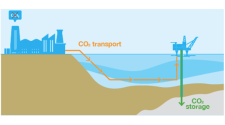
In October 2022, Quintessa attended the 16th International Conference on Greenhouse Gas Control Technologies (GHGT-16), in Lyon, France. The GHGT conference series is established as the principal international conference on greenhouse gas mitigation technologies, focussing on Carbon Capture, Utilisation and Storage (CCUS).
Renato Zagorscak attended GHGT-16 to present the register of risks and mitigations associated with CCUS on the UK Continental Shelf (UKCS). As announced previously, Quintessa has worked closely with TNO, Merlin Energy and world experts on CCUS Prof Stuart Haszeldine, Iain Wright, Klaas van Alphen and Graham Wadelin to develop the risk register and assist the North Sea Transition Authority (NSTA) in carbon storage licence stewardship.
The paper that Quintessa published in the Conference proceedings outlines a process undertaken to describe the risks and mitigations which must be considered as part of a Carbon Capture and Storage (CCS) project on the UKCS and the creation of a risk register to assist the NSTA to carry out its key responsibilities (see Figure 1). The risk register is based on the current understanding of offshore subsurface storage of CO2 from various state-of-the-art projects that have been carried out to date. Some of these projects are fully commercial ventures, whereas others are first of a kind demonstration projects or designed to facilitate research.
Overall, the risk register comprises: the main checklist, which covers risk categories central to NSTA’s regulatory role; the wider factors checklist, which covers risks that, although outside the NSTA’s regulatory remit, are pertinent to ensuring the success of a CCS project; and individual risk review forms, which include detailed project-specific risks used in the risk collation process and formation of the risk register. Risks apply at different stages in the storage process and are relevant over time periods of different length, extending to thousands of years.
As experience grows from the implementation of CCS projects on the UKCS, it is likely that improved information will become available about risks that might occur and the preventative measures or mitigations that satisfy UK’s regulatory regime, which can then be directly incorporated into the risk register.

Figure 1: Methodology for developing the risk register.